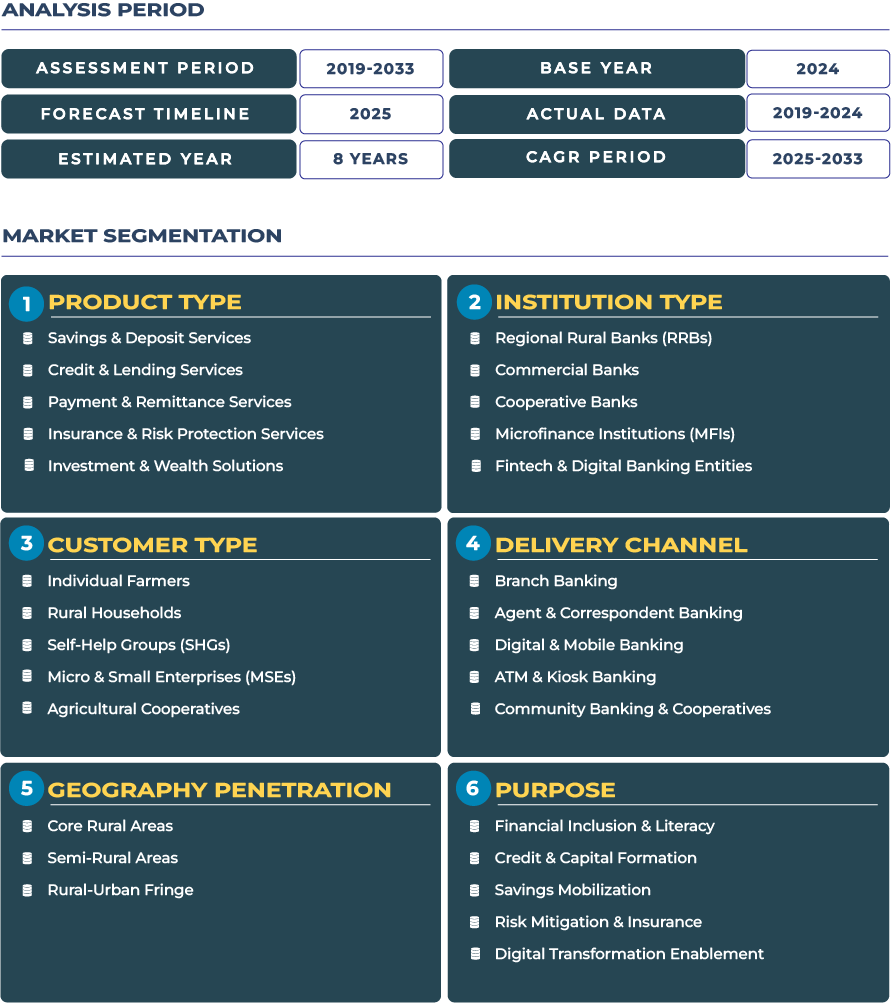Eastern Europe Rural Banking Market Outlook: Transitional Modernization through EU Integration Redefines Rural Finance
Eastern Europe rural banking market is undergoing a measured yet impactful transformation as EU-aligned integration, modernization funds, and digital finance initiatives reshape its operational and credit frameworks. The region rural banking sector, valued at USD 17.9 billion in 2025, is projected to reach USD 20.6 billion by 2033, growing at a CAGR of 1.8% from 2025 to 2033, according to DataCube Research. This growth trajectory reflects not just economic recovery but structural alignment with broader EU financial systems emphasizing credit transparency, rural inclusivity, and agricultural productivity enhancement.
Note:* The market size refers to the total fees/revenue generated by banks through various services.
The transition theme of Transitional Modernization through EU Integration underscores the gradual harmonization of Eastern Europe’s rural finance ecosystem with pan-European regulatory standards. Modernization credit lines, supported by EU’s European Commission and the European Investment Bank, are improving credit access and strengthening cooperative banking resilience. Rural regions across Poland, Romania, and Bulgaria are increasingly utilizing EU Cohesion Funds to upgrade agricultural infrastructure, rural payment systems, and insurance frameworks. Despite macroeconomic headwinds and ongoing geopolitical uncertainty in Eastern Europe, especially surrounding Russia–Ukraine tensions, the sector remains a cornerstone for rural livelihoods and SME-led economic growth.
Drivers & Restraints: EU Capital Flows and Donor Projects Counter Legacy Credit Challenges
EU-Driven Infrastructure and Contract Farming Spur Rural Banking Growth
A key growth driver in the Eastern Europe rural banking market lies in the expanding ecosystem of contract farming and donor-funded infrastructure projects. Western European buyers increasingly depend on Eastern European rural producers for agri-exports, incentivizing credit lines for storage, logistics, and quality certification. The OECD reported in 2024 that agri-export financing in countries like Poland and Hungary rose by over 12%, driven by modernization credit schemes and co-financed EU agricultural guarantees. Meanwhile, donor projects from institutions like the World Bank and Common Agricultural Policy (CAP) are modernizing rural payment infrastructures and identity-linked lending models, enabling higher financial inclusion. The development of low-interest digital lending platforms and payment-based microfinance for rural cooperatives has further expanded access to structured finance.
Legacy NPLs and Fragmented Land Registries Limit Lending Efficiency
However, the industry continues to face structural challenges. Legacy non-performing loans (NPLs) remain a persistent drag in rural cooperative banks, particularly in Southeast European economies. Land registry modernization remains incomplete in several non-EU member states, limiting collateralized lending. The National Bank of Romania has noted that outdated land documentation reduces the reliability of asset-backed financing. Additionally, the low-margin environment in traditional banking discourages investment in rural financial digitization, while population decline in some areas increases per-customer acquisition costs. These combined factors temper the market’s overall growth potential despite increasing rural financial demand.
Trends & Opportunities: Digital Payments, Remittance Growth, and EU-Aligned Financing Define the Next Phase
Cross-Border Financing and Remittance-Linked Savings Drive Structural Shifts
The most transformative trend across the Eastern European rural banking landscape is the rise of cross-border trade financing and remittance-linked savings models. Rural households in Moldova, Romania, and the Baltic states are increasingly leveraging digital remittance channels to accumulate savings and secure small loans. Telecom–fintech partnerships are expanding digital payment infrastructure in rural zones, as evidenced by the October 2025 launch of new mobile-based payment networks in Slovakia and Croatia. These partnerships are enabling secure, identity-verified payments while fostering financial literacy through mobile-first models.
Emerging Opportunities in Warehouse Receipt Finance and Diaspora-Backed Mortgages
One of the most promising opportunities lies in warehouse-receipt finance tied to EU modernization grants, allowing farmers to leverage stored commodities as collateral. Additionally, diaspora-backed mortgage instruments are growing rapidly as expatriates reinvest in rural real estate and agribusiness ventures. This model, backed by consistent remittance inflows, reduces default risk and stabilizes credit portfolios. Such initiatives, supported by the European Bank for Reconstruction and Development (EBRD), exemplify how policy alignment and innovation are converging to fortify rural liquidity and resilience.
Regional Analysis by Country
Russia
Russia rural banking market remains affected by geopolitical constraints and limited access to Western capital markets. Despite these challenges, domestic financial institutions are focusing on import substitution lending, agritech support, and localized credit schemes to sustain rural economies. The Central Bank of Russia continues to promote rural SME lending diversification while introducing digital ruble trials in remote banking networks to enhance inclusion.
Poland
Poland rural banking sector leads Eastern Europe in digital modernization and EU-aligned credit programs. The Polish Financial Supervision Authority (KNF) has actively promoted cooperative banking consolidation and fintech integration to improve scalability. Rural credit unions have been instrumental in delivering low-interest agri-loans, digitized remittance systems, and weather insurance for small farmers, positioning Poland as a benchmark for EU-cohesive rural finance.
Competitive Landscape: Financial Cooperatives, Telecom Partnerships, and Policy-Driven Innovation
Eastern Europe’s competitive rural banking ecosystem is anchored by regional leaders such as Bank Polski, Raiffeisen Bank, and OTP Bank. In October 2025, strategic telecom–fintech partnerships across the Balkans introduced rural digital payment ecosystems, expanding financial inclusion through agent-based banking. Meanwhile, June 2025 saw new warehouse-receipt lending programs launched in Bulgaria and Slovakia to link small producers with storage-backed credit. Cooperative banks are simultaneously introducing diaspora-linked mortgages and green loan portfolios, reinforcing sustainability and cross-border capital integration.








